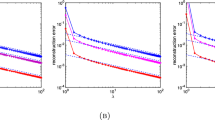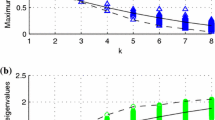Abstract
Sigma Delta (\(\Sigma \Delta \)) quantization, a quantization method first surfaced in the 1960s, has now been widely adopted in various digital products such as cameras, cell phones, radars, etc. The method features a great robustness with respect to quantization noises through sampling an input signal at a Super-Nyquist rate. Compressed sensing (CS) is a frugal acquisition method that utilizes the sparsity structure of an objective signal to reduce the number of samples required for a lossless acquisition. By deeming this reduced number as an effective dimensionality of the set of sparse signals, one can define a relative oversampling/subsampling rate as the ratio between the actual sampling rate and the effective dimensionality. When recording these “compressed” analog measurements via Sigma Delta quantization, a natural question arises: will the signal reconstruction error previously shown to decay polynomially as the increase of the vanilla oversampling rate for the case of band-limited functions, now be decaying polynomially as that of the relative oversampling rate? Answering this question is one of the main goals in this direction. The study of quantization in CS has so far been limited to proving error convergence results for Gaussian and sub-Gaussian sensing matrices, as the number of bits and/or the number of samples grow to infinity. In this paper, we provide a first result for the more realistic Fourier sensing matrices. The main idea is to randomly permute the Fourier samples before feeding them into the quantizer. We show that the random permutation can effectively increase the low frequency power of the measurements, thus enhance the quality of \(\Sigma \Delta \) quantization.




Similar content being viewed by others
References
Ai, A., Lapanowski, A., Plan, Y., Vershynin, R.: One-bit compressed sensing with non-gaussian measurements. Linear Algebra Appl. 441, 222–239 (2014)
Baraniuk, R., Foucart, S., Needell, D., Plan, Y., Wootters, M.: Exponential decay of reconstruction error from binary measurements of sparse signals. arXiv preprint arXiv:1407.8246 (2014)
Benedetto, J.J., Powell, A.M., Yılmaz, Ö.: Sigma-delta (\(\Sigma \Delta \)) quantization and finite frames. IEEE Trans. Inf. Theory 52(5), 1990–2005 (2006)
Blum, J., Lammers, M., Powell, A.M., Yılmaz, Ö.: Sobolev duals in frame theory and sigma-delta quantization. J. Fourier Anal. Appl. 16(3), 365–381 (2010)
Bodmann, B.G., Paulsen, V.I., Abdulbaki, S.A.: Smooth frame-path termination for higher order sigma-delta quantization. J. Fourier Anal. Appl. 13(3), 285–307 (2007)
Bourgain, J.J.: An improved estimate in the restricted isometry problem. In: Geometric Aspects of Functional Analysis. Springer, Berlin, pp. 65–70 (2014)
Cai, T., Zhang, A.: Sparse representation of a polytope and recovery of sparse signals and low-rank matrices. IEEE Trans. Inf. Theory 60, 122–132 (2014)
Candes, J.E.: The restricted isometry property and its implications for compressed sensing. Comptes Rendus Mathematique 346(9), 589–592 (2008)
Candès, E.J., Romberg, J., Tao, T.: Robust uncertainty principles: exact signal reconstruction from highly incomplete frequency information. IEEE Trans. Inf. Theory 52(2), 489–509 (2006)
Cheraghchi, M., Guruswami, V., Velingker, A.: Restricted isometry of fourier matrices and list decodability of random linear codes. SIAM J. Comput. 42(5), 1888–1914 (2013)
Chou, E., Güntürk, C.S., Krahmer, F., Saab, R., Yılmaz, Ö.: Noise-shaping quantization methods for frame-based and compressive sampling systems. arXiv preprint arXiv:1502.05807 (2015)
Chou, E., Güntürk: Distributed noise-shaping quantization: I. beta duals of finite frames and near-optimal quantization of random measurements. arXiv preprint arXiv:1405.4628, (2015)
Daubechies, I., DeVore, R.: Approximating a bandlimited function using very coarsely quantized data: a family of stable sigma-delta modulators of arbitrary order. Ann. Math. 158(2), 679–710 (2003)
Deift, P., Güntürk, C.S., Krahmer, F.: An optimal family of exponentially accurate one-bit sigma-delta quantization schemes. Commun. Pure Appl. Math. 64(7), 883–919 (2011)
Feng, J., Krahmer, F.: An RIP-based approach to \(\Sigma \Delta \) quantization for compressed sensing. IEEE Signal Process. Lett. 21(11), 1351–1355 (2014)
Foucart, S.: Stability and robustness of \(\ell _1\)-minimizations with Weibull matrices and redundant dictionaries. Linear Algebra Appl. 441, 4–21 (2014)
Güntürk, C.S.: One-bit sigma-delta quantization with exponential accuracy. Commun. Pure Appl. Math. 56(11), 1608–1630 (2003)
Güntürk, C.S., Lammers, M., Powell, A.M., Saab, R., Yılmaz, Ö.: Sobolev duals for random frames and sigma-delta quantization of compressed sensing measurements. Found. Comput. Math. 13(1), 1–36 (2013)
Haviv, I., Regev, O.: The restricted isometry property of subsampled fourier matrices. In: Klartag, B., Milman, E. (eds.) Geometric Aspects of Functional Analysis, pp. 163–179. Springer, Berlin (2017)
Huynh, T.: Accurate quantization in redundant systems: From frames to compressive sampling and phase retrieval. Ph.D. Thesis, New York University (2016)
Inose, H., Yasuda, Y.: A unity bit coding method by negative feedback. Proc. IEEE 51(11), 1524–1535 (1963)
Iwen, M., Saab, R.: Near-optimal encoding for sigma-delta quantization of finite frame expansions. J. Fourier Anal. Appl. 19(6), 1255–1273 (2013)
Jacques, L., Laska, J.N., Boufounos, P.T., Baraniuk, R.G.: Robust 1-bit compressive sensing via binary stable embeddings of sparse vectors. IEEE Trans. Inf. Theory 59(4), 2082–2102 (2013)
Knudson, K., Saab, R., Ward, R.: One-bit compressive sensing with norm estimation. arXiv preprint arXiv:1404.6853 (2014)
Krahmer, F., Saab, R., Ward, R.: Root-exponential accuracy for coarse quantization of finite frame expansions. IEEE Trans. Inf. Theory 58(2), 1069–1079 (2012)
Krahmer, F., Saab, R., Yılmaz, Ö.: Sigma-Delta quantization of sub-Gaussian frame expansions and its application to compressed sensing. Inf. Inference 3(1), 40–58 (2013)
Lammers, M., Powell, A.M., Yılmaz, Ö.: Alternative dual frames for digital-to-analog conversion in sigma-delta quantization. Adv. Comput. Math. 32, 73–102 (2008)
Mackey, L., Jordan, M., Chen, R., Farrell, B., Tropp, J.: Matrix concentration inequalities via the method of exchangeable pairs. Ann. Probab. 42(3), 906–945 (2014)
Maricic, D.: Image sensors employing oversampling sigma-delta analog-to-digital conversion with high dynamic range and low power. University of Rochester, Diss (2011)
Pe na, V., Giné, E. (eds.): Decoupling: From Dependence to Independence. Springer, Berlin (2012)
Plan, Y., Vershynin, R.: One-bit compressed sensing by linear programming. Commun. Pure Appl. Math. 66(8), 1275–1297 (2013)
Plan, Y., Vershynin, R.: Robust 1-bit compressed sensing and sparse logistic regression: a convex programming approach. IEEE Trans. Inf. Theory 59(1), 482–494 (2013)
Powell, A.M., Saab, R., Yılmaz, Ö.: Quantization and finite frames. In: Casazza, P.G., Kutyniok, G. (eds.) Finite Frames, ANHA, pp. 267–302. Birkhäuser, Boston (2013)
Rudelson, M., Vershynin, R.: On sparse reconstruction from fourier and gaussian measurements. Commun. Pure Appl. Math. 61(8), 1025–1045 (2008)
Saab, R., Wang, R., Yılmaz, Ö.: Quantization of compressive samples with stable and robust recovery. preprint arXiv:1504.00087 (2015)
Saab, R., Wang, R., Yılmaz, Ö: From compressed sensing to compressed bit-streams: practical encoders, tractable decoders. IEEE Trans. Inf. Theory (to appear) (2017)
Vershynin, R.: A simple decoupling inequality in probability theory. Preprint (2011)
Acknowledgements
The author would like to thank Rayan Saab, Özgur Yılmaz and Joe-Mei Feng for valuable discussion about the topic. R. Wang was funded in part by an NSERC Collaborative Research and Development Grant DNOISE II (22R07504).
Author information
Authors and Affiliations
Corresponding author
Additional information
Communicated by Roman Vershynin.
Rights and permissions
About this article
Cite this article
Wang, R. Sigma Delta Quantization with Harmonic Frames and Partial Fourier Ensembles. J Fourier Anal Appl 24, 1460–1490 (2018). https://doi.org/10.1007/s00041-017-9582-2
Received:
Revised:
Published:
Issue Date:
DOI: https://doi.org/10.1007/s00041-017-9582-2




